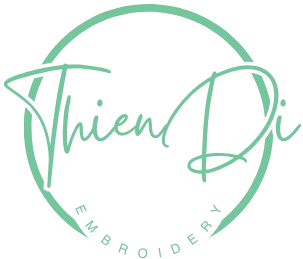INTRODUCTION
1, About Thien Di Embroidery
Founded by Le Cong Hanh, the pioneer of the embroidery profession, Quat Dong village’s traditional embroidery has been well-known since the 17th century. The embroidery industry has existed since the village’s establishment and has continued to flourish over time.
Embroidery has become an essential component of the daily existence of the Quat Dong community. However, life is changing, and like many other professions, industrial embroidery machines are contributing to the modernization of embroidery, trying to replace traditional embroidery. Never give up, Quat Dong hand embroidery artisans continue to practice their ancestors’ ancient methods. Because of their uniqueness, the love and passion that each artisan puts into each needle and thread, and the love, respect, and pride that each product embodies in the craft, Quat Dong hand-embroidered products continue to have their own voice in the market and cannot be combined with industrial embroidery products that are mass-produced.
In an effort to uphold and preserve the esteemed traditional cultural values of the Vietnamese people, Thien Di Import Export Company Limited is committed to promoting these traditional products to international friends. It is hoped that these artistic creations will be embraced by all and will enhance the quality of life through their aesthetic appeal.
2, The founder of embroidery
Le Cong Hanh’s birth name was Tran Quoc Khai. He was born in the year of Binh Ngo (1606) in Quat Dong commune, Thuong Tin district, Ha Dong province (now Thuong Tin district, Hanoi).
He served as an envoy to the Ming Dynasty in the year of Binh Tuat (1646). He unintentionally picked up the needlework technique during this mission, taught it to the residents of Quat Dong village, and then spread it to neighboring provinces, such as Bac Ninh and Hung Yen.
Furthermore, he instructed the populace on how to create parasols. Following Le Cong Hanh’s death (in 1661), the locals erected a temple in his honor as the creator of the embroidered craft in remembrance of his virtues.
According to some documents, needlework and parasol-making were already practiced in our nation before Le Cong taught them to the populace. They did, however, start out tiny, using very basic methods, only used a few colors of thread, and mostly catered to the king and officials.
3, Features of conventional professions
Quất Động village embroidery is divided into 3 types:
– Embroidery (landscapes, flowers, animals, place names, …)
– Portrait embroidery (Kings, historical figures, heads of state, …)
– Embroidery of royal costumes, restoration of costumes, …
Among them, stitching is thought to be the most straightforward since it allows the embroiderer to freely express their feelings. Depending on their passion and love for their work, the delicate or harsh lines will reveal the painting’s quality.
The reason portrait stitching is the hardest is because you have to feel and comprehend the character’s energy and then know how to convey that essence through the lines; if you are not sensitive, it will not work.
The guidelines for royal costume embroidery and restoration must be strictly followed; the rank of each costume type must be indicated, the color and pattern must be precise, and no originality is permitted.
Royal costume embroidery and restoration necessitates rigorous respect to the established guidelines, which state that each costume type’s rank, colors, and patterns must be precise and that originality is not permitted.
From traditional groups like parallel sentences, ceremonial gates, parasols, flags, canopies, tablecloths, and traditional stage costumes to imaginative landscape and portrait embroidery like Uncle Ho’s stilt house, One Pillar Pagoda, and Lenin’s portrait, Quat Dong village embroidery artists have produced a vast array of items.
4, The production process of traditional products
a, Production materials
The main requirements for individuals who work in embroidery are perseverance, attention to detail, and a sense of collaboration; the craft itself is not particularly difficult. Embroidery requires very basic tools. At the very least, embroidery frames, round and rectangular embroidery needles, scissors, rulers, brushes, chalk, embroidery fabric (such as silk, satin, or white cloth), and different colored embroidery threads are the only supplies used by embroiderers. Thus, embroidery is a great fit for our nation’s workforce, particularly in rural areas. As the vibrant shapes and colors gradually emerge, the needle tip rapidly swings back and forth.
– Thread: silk thread and thick thread
– Embroidery fabric: embroidery fabric or fashion embroidery fabric (embroidery clothes, embroidery pillowcases …)
– Embroidery frame: round embroidery frame or rectangular frame.
b, Stage of production
Cutting, printing, embroidery, inspection (technical and finishing embroidery), washing, and packaging are the fundamental steps in the manufacture of lace embroidery items.
Along with the offered embroidered designs, artists may also make needlework from your requested paintings or photos, allowing you to preserve those images with incredibly beautiful and long-lasting pieces.
c, Techniques for embroidery
The artisans of Quat Dong hamlet have combined new, intricate embroidered techniques, like double-sided embroidery, with traditional embroidery techniques over time. Silk embroidery thread, which is highly popular, is used to create double-sided embroidery on thin chiffon fabric. Because the artist conceals the thread in the center, it is impossible to discern where the beginning and ends of a double-sided embroidery are. Because of this, only experienced needleworkers can become proficient in double-sided embroidery, which also takes three to four times longer than standard embroidery.
However, life is changing, and like many other professions, industrial embroidery machines are contributing to the modernization of embroidery, trying to replace traditional embroidery. Never give up, Quat Dong hand embroidery artisans continue to practice their ancestors’ ancient methods. Because of their uniqueness, the love and passion that each artisan puts into each needle and thread, and the love, respect, and pride that each product embodies in the craft, Quat Dong hand-embroidered products continue to have their own voice in the market and cannot be combined with industrial embroidery products that are mass-produced.
In an effort to uphold and preserve the esteemed traditional cultural values of the Vietnamese people, Thien Di Import Export Company Limited is committed to promoting these traditional products to international friends. It is hoped that these artistic creations will be embraced by all and will enhance the quality of life through their aesthetic appeal.







